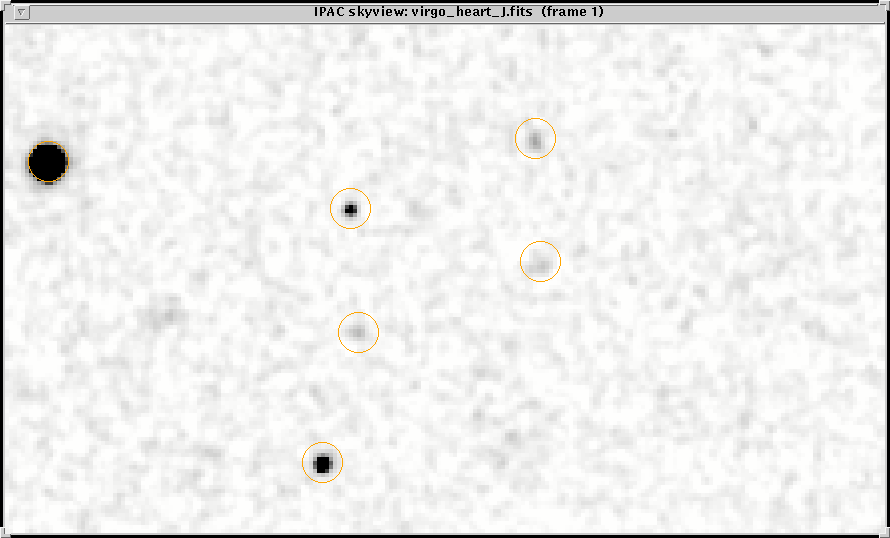XSC -- Virgo Galaxy Cluster
The Virgo Galaxy Cluster, provides a unique testbed to validate the completeness of the XSC. Owing to its close proximity (Vh = 1000 km/s; D ~ 20 Mpc), cluster richness, and extreme angular size (over 50 sq. deg), Virgo contains a variety of galaxies from the big (e.g., M87) to the very small or low surface brightness (e.g., IC3475) that is within the sensitivity and resolution reach of the XSC. Here we use large 2MASS image mosaics to search for Virgo galaxies that are absent from the XSC.
We visually inspect the mosaics, overlaying extended sources from the 2MASS database (WSDB) and the XSC, scanning the images for obvious Virgo galaxies missing from the XSC. This experiment is optimized to clearly resolved galaxies (diameters > 10-20 arcsec), and less so to compact (possibly background) galaxies. Our goal is to identify Virgo galaxies and to ascess the completeness of the 2MASS XSC.
Two experiments are carried out: (1) inspect a low spatial resolution, but angularly large, 50 deg2, Virgo mosaic, and (2) inspect a full resolution, 3 deg2, Virgo mosaic. For the large mosaic, we only concentrated upon the XSC detections, and do not consider previously cataloged galaxies (which may or may not be visible in the 2MASS images). For the full resolution mosaic, we consider the XSC and PSC, as well as NED (previously catalogued) detections.
a. Bottom Line ResultsThe overall XSC completeness for the Virgo Galaxy Cluster is well above 90%, exceeding the 2MASS Level-1 Science Requirements for absolute completeness. The reliability looks solid as well (although this experiment was not optimized to assess the detailed reliability). The only galaxies that are missing from the XSC are faint, low surface brightness objects that either exceed the S/N thresholds of the XSC or are at the limit of reliable detection and characterization. All of the large, major galaxies of Virgo are included in the XSC. |
b. What is missing from the XSC?
The dominent population of galaxies missing from the XSC are small and faint, both pushing at the limits of detection and star-galaxy separation. The plot below shows the Jmag vs. Jsig distribution of XSC Virgo galaxies (marked with white points) and extended sources identified through visual inspection of the full resolution Virgo mosaic (marked with red points). Most of the sources are either fainter than the Level-1 Science requirement (J = 15 mag) or have a S/N that extends well below the requirement limits (S/N = 10). One of the brightest "missing" sources (UGC 7652) is a satellite galaxy of M87 (see the M87 Virgo Panel); hence, this source is swept into the larger field of M87 (Virgo A) through the Large Galaxy Atlas.
Consider the curious case of IC 3388, a Virgo dwarf galaxy.
This object is relatively bright (J ~ 14.4 mag) in
total integrated flux, but it is
low in surface brightness (see images below).

April 20, 2000 image of the IC3388 Region
It was observed twice by 2MASS: (1) Dec 6, 1998 from the
northern hemisphere telescope, and (2) April 20, 2000
from the southern hemisphere telescope.
For the 1998 observation, it was not detected by 2MASS,
and for the 2000 observation it was detected and
extracted into the 2MASS working extended
source database.

Dec 6, 1998 image of the IC3388 Region
For the public release catalogs,
the 1998 observation (2MASS tile)
was deemed superior to the 2000 observation (tile)
in background sensitivity, and hence was used in the XSC.
The unintended consequence is that IC3388 is not in the XSC -- it is
missing from the public release catalog, yet it safely resides in the extended source
database.
Other notable Virgo galaxies missing from the XSC are shown here.
Bottom line statistics: 120 galaxies brighter than S/N = 10 (J ~ 15 mag) and 8 galaxies brighter than J=15 missing from the XSC. 93 +-3% completeness based on visual inspection of the 2MASS images.
c. LSBs and other "invisible" Galaxies
The relatively shallow 2MASS survey is not optimized to detect (face-on) late-type spirals, dwarfs and other low surface brightness (LSB) galaxies. Only the nearest and physically largest LSBs are clearly delineated and characterized in the XSC (see for example, NGC 6822). For the Virgo Cluster, dwarfs are, for the most part, invisible to 2MASS.
d. The PSC Contains Many (Faint) Virgo Galaxies
The 2MASS Point Source Catalog (PSC) includes many extragalactic sources, both of the extended and of the compact or point-like variety. The Virgo mosaics are full of faint point sources that are undoubtedly galaxies (based on their "soft" surface brightness and "red" colors). The image below shows a small Virgo area with PSC sources demarked with orange circles. Three of the demarked sources are faint galaxies, with integrated J mags much fainter than the XSC limits, but well within the sensitivity limits of the PSC. For a larger view of PSC and XSC sources, view the full resolution Virgo mosaic panels.
And now, on to the Visual Inspection and Analysis Experiments ...
e. 2MASS VIRGO Sample
Equatorial Region of Entire Virgo Cluster:-
183.3 < RA < 191.1 deg
10.4 < Dec < 16.4 deg
The "Heart of Virgo" region consists of the central three square degrees of the cluster, bordered by M87 in the south, and the Markarian Chain of galaxies to the north (including M84, M86).
f. Sky Distribution
Virgo lies within the supergalactic plane of nearby galaxy clusters (see for example the XSC allsky image). A flat "tangent" projection of the XSC (integrated flux)within the Virgo area is given here (caution: this image is very large,9 Mb); centered at 12.4hr +12.7deg, with an 8X8 degree field of view.
g. Visual Inspection Analysis
- Low Spatial Resolution, 50 deg2 Mosaic
- Full Resolution, 3 deg2 Mosaic, "Heart of Virgo"
[Last Updated: 2003 Jan 30 ; by Tom Jarrett]

